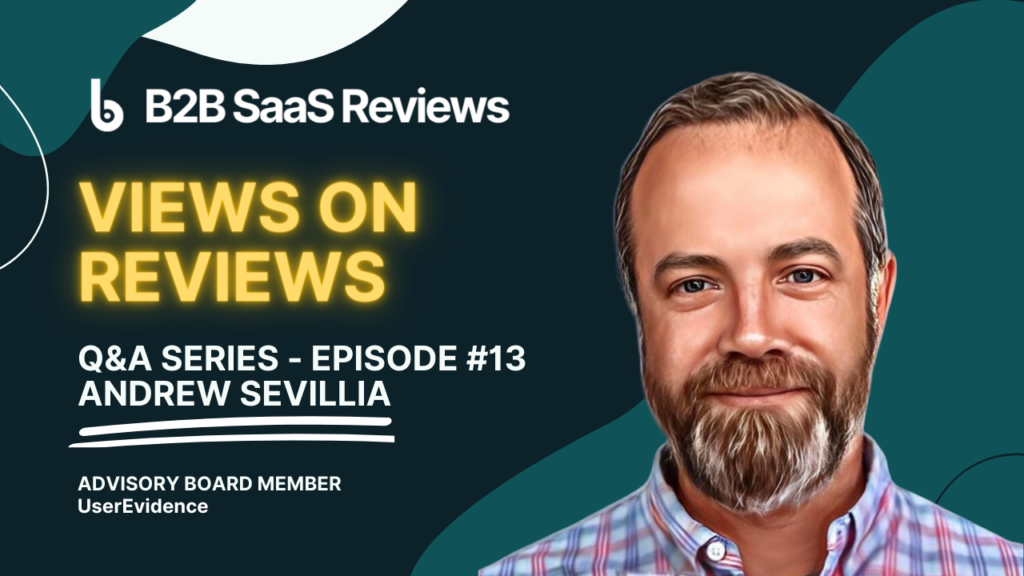Views on Reviews is a series of interviews with B2B SaaS professionals who provide a real-world perspective on what it’s like working on reviews. The thirteenth interview is with Andrew Sevillia, an Advisory Board Member at UserEvidence. In it, he shares his views on customer references and reviews.

Andrew Sevillia is an Advisory Board Member at UserEvidence, a SaaS platform that arms B2B vendors with verified customer evidence, proof points, and success stories to prove the value of their products.
He has been a customer marketer for (SAP) CallidusCloud, (Oracle) Netsuite, Juniper Networks, Planful, and Sage Intacct. He has also been recognized as a Top100 CMA Strategist for two years running (2022 and 2023).
His colleagues and peers know him as someone who:
- …stands out not only for his skillful approach to interviewing and cultivating customer relationships but as an expert in building highly effective customer advocacy programs.
- …is hands down the best Customer Marketing leader I have worked with in my career.
- ….a warm individual and an amazing coworker.
Without further ado, here are Andrew’s views on reviews.
What are the takeaways on customer references and reviews?
If you’re short on time, here’s the key takeaways on customer references and reviews”
- On why reviews matter: Where I think buyers get the most insight is from hearing directly from people who look just like them….let me read or hear from other people who are like…same industry, same company size, similar challenges. And that’s where these review sites come in.
- On review sites: I’ve worked with G2, TrustRadius, and Gartner Peer Insights for many years. G2 has the traffic, TrustRadius has the content (i.e. the reviews are more in-depth), and Gartner Peer Insights has reviews tied into a Magic Quadrant (which matters if there is one for your category.) So when it comes to prioritizing review sites, it depends on your objectives. (Editor’s note: You can add Gartner Digital Markets for PPC-driven lead gen, PeerSpot for capturing more reviews from IT buyers, etc.)
- On review generation: Review site-driven review requests are a quick and easy option but tend to have lower conversion rates than if you owned the requests. Consider adding a review request on your app login page, at customer conferences, and enable your CS and Support teams to ask at moments when you’re top of mind for your customers. Automate the review process on your end where possible to lighten the load on your team.
- On how to leverage reviews: You can leverage reviews in a few ways: sourcing advocates, creating content and promoting your voice of the customer to prospects showing buyer intent.
- On going beyond reviews and building a customer reference program for Sales: Process is critical because the less you have of it, the more you need to add technology and people to it. Building a process in your CRM that allows Sales reps to self-serve — find, select, and request a reference — and automatically send the requests to Customer Success to fulfill can save you a lot of time and money.
Here’s the full interview with Andrew.
Words of Wisdom from Andrew Sevillia: The Interview
You’re a Customer Marketing veteran. How did you get started with customer reviews?
Reviews are near and dear to my heart. It falls squarely within the purview or the charter of the customer advocacy function. And it’s interesting…I’ve been in this space for about 15 years, and it wasn’t until the early 2010s that this start started to really become something we needed to focus our time, energy, effort, and resources towards.
Why do reviews matter to B2B SaaS buyers?
The case for why this is important is very simple. When you’re gonna buy something, it doesn’t matter what it is, car, TV, software, you wanna go and do your due diligence, you wanna do your research, you wanna do your homework because you wanna make an informed buying decision. Vendors are gonna put out all kinds of material about why their product is the best, fastest, and most robust. And that’s fine, you should read that stuff and consider it. But where I think buyers get the most insight is from hearing directly from people who look just like them. I’ve got a need, or I’ve got a problem, I’ve got a challenge, I’ve identified a list of solutions: in this case, software vendors and I’m not sure which one’s the right one for me. So let me read or hear from other people who are like me again. Maybe same industry, same company size, similar challenges. And that’s where these review sites come in.
How do you prioritize review sites?
The number of review sites has expanded from a few to several. There’s now G2, TrustRadius, Gartner Peer Insights, PeerSpot, Gartner Digital Markets, and others. I’ve worked with G2, TrustRadius, and Gartner Peer Insights for many years. G2 has the traffic, TrustRadius has the content (i.e. the reviews are more in-depth), and Gartner Peer Insights has reviews tie into a Magic Quadrant (if there is one in your category. So when it comes to prioritizing review sites, it depends on your objectives.
I also interview customers and ask them how did they learn about us? They’ll typically say something like, “Oh, well, I tapped into my network, or I did some Google searching. And then ultimately we read through the reviews on ABC review site.” And I’m like, oh, that’s great. Okay. So I need that. I’m gonna take that back to my marketing leadership and say, Hey, that investment we’re making, here’s where the rubber meets the road.
While you were Director, Customer Marketing at Sage Intacct, you drove a 500% increase in the number of online reviews on targeted review sites. How’d you do it?
I’m happy to tell that story. So when you engage with the review platforms, they’re gonna say, Hey, here’s what we want you to do. We want you to hand over a list of at least 500 contacts, and then we’ll go out and do a reviews campaign on your behalf. And what is that reviews campaign? Well, they’re gonna send three emails over a week or two. And so basically what they’re doing, they’re just sending email that say, Hey, we’re G2, and Sage intact has asked us to reach out to you to write a review on them. And the review sites, they kept telling me over and over, we’re seeing an 8 to 15% conversion in this approach to generating reviews. And I’m like, oh, okay. So I tried it maybe for a year. Every quarter, here’s a list of 1500 people. I was lucky if it was 1 to 3% conversion. So if I gave them 500 names, I would get anywhere from 5 to maybe 15 reviews….And that was just…not working. So I was like, okay, that didn’t work. Try something else. So we were brainstorming, how are we gonna do this? So we said, well, we have a SaaS product, so anybody who wants to use our product, they have to log in through our website. And so what we did was we put the review CTA right next to the login for our product. And I’m not kidding, we got 5-10 reviews a week…. it’s an always on. It’s not another email in your inbox. It’s prominently displayed right next to the login, go write a review, you’re gonna get a $25 gift card. And every quarter we would change out which review site we were directing customers to. So Q1 was G2, Q2 was TrustRadius, and then leading up to Gartner Magic Quadrant season, it was Gartner Peer Insights. So that was huge.
The other big one was we had a big annual customer conference and we’d have 2,500 customers attend. So here’s the thing, you’re not gonna go to, at least I’m not going to go to, a conference for a company, a tool that I use that I don’t like that tool. Why would I go, right? So you’re pretty much guaranteed that these 2000 to 2,500 people are gonna be at these satisfied customers. We had a booth, it was our advocacy lounge. We invited everybody to come and hang out. And there was some swag and we’d sign people up for the advocacy program and talk ’em through it, do a quick interview. We also did this thing where we made a postcard. And on the postcard it said, write a review and you’ll receive a $25 gift card. But rather than just have one review site, we had three. There were QR codes for G2, TrustRadius, and Gartner Peer Insights. And so the we positioned it was, Hey, you can get $75 worth of Amazon gift cards, all you gotta do is go is write a review and submit it on three sites. It’s really simple. So that we would see, in the course of four days, we got 250 new reviews, or refreshed reviews from people who had written a review…the weight of a review degrades over time on a review site of rade is over time, so if somebody’s already written a review six months ago or whatever, when they go and they update the review, the review regains its value and is weighted like a new review.
What are your review generation tips?
Customer Success should be your BFF. I need them to help me understand which customers are having a good experience and help me get my foot in the door with customers. I need to empower my CS team to make the ask to customers when they’re doing their QBR or they’ve had a good conversation with a customer, So kind of spreading the wealth or the ask around to other people, I think that’s also important.
Another underused review tactic is asking for reviews when closing out a support ticket. When a support ticket is closed, an automated email goes out asking for feedback to the customer and it says, Hey, someone close the support ticket. How would you rate your experience? This can trigger the next message, which could be a review request.
Since reviewers can be a source of customer advocates, can customer advocates can be a source of review candidates?
Absolutely. So if you have a customer advocacy platform, and there’s a number of them on the market now, you can spin up a challenge or ask where you’re putting the opportunity to go write a review in front of your advocates, the people who you’ve qualified who have said, yes, I wanna join, and I will participate in your sales and marketing opportunities.
Once you have user reviews, how do you leverage them?
You can leverage reviews in a few ways: sourcing advocates, creating content and promoting your voice of the customer to prospects showing buyer intent.
Content creation:
So somebody writes a review and they’re, let’s say they’re a CFO for a pharma company and I have little to no content for in the pharma industry. I can take that review and then build a full-blown case study. And even if that’s a no-go, I can take that review content publicly available on a public website and then use it in my marketing. I can pull quotes out and put them in an ebook, give it to my product marketing team and they can use it in the content that they’re working on, whitepaper, you name it, right? Make sure if it’s public-facing, it’s linked back to the review on the site.
Promotion:
Each review site has some form of report or score that you want to perform well on. You’re always trying to move up and to the right (on their grids.) and earn trust badges. You can leverage your category rank, score, and badges in your ads, press releases, and social media. You can also leverage review site buyer intent data and other sources of intent data to target your prospects.
Customer advocate sourcing:
If they wrote a positive review, thank them and ask for a conversation to learn more about their experience and see if they’re open to being in your customer advocacy program, sales reference program, or whatever voice of the customer initiatives you’re looking to build. Reach out to and say, Hey, thank you so much for taking the 10, 15 minutes to write this review. I’d love to learn more about you and your background and your business and how you’re using our software. Would you be open to spending 30 minutes with me? So this is a warm funnel for my advocacy program. It’s always on. And so it unburdens me, or I would say it just takes some of the hunting and pecking right around in Salesforce or trying to get your CS team to say, Hey, I had a great conversation with so and so at ABC Company, I’m gonna intro you…I can be a bit more proactive in how I’m recruiting for my advocacy program.
How do you get internal buy-in to spend resources on review generation?
The review sites have lots of documentation about how impactful they can be in terms of intent data, lead generation, advocate identification, and churn reduction. In my experience, most Marketing leaders understand the importance of having lots of reviews, so it’s not tough to make a case for needing budget.
Few have the experience that you have in customer references. At CallidusCloud, NetSuite, Juniper Networks, Planful, and Sage Intacct customer references seemed to be your specialty. How do you approach references?
I think of references in two categories:
- Marketing references: all the public-facing stuff, like webinar speakers, case studies, video testimonials, press releases, analyst reports, getting customer stories in industry or business publications.
- Sales references: these are closed opportunities, meaning they don’t happen out in the public. They’re usually a one-on-one phone call between a customer and a prospect.
In the review process, reviewers are asked, would you be willing to be a Sales reference? I call those who select “yes” (to be a Sales reference) to understand their story. Were they around when it was bought? Have they realized the value they expected? If yes to both, I’ll ask them to be a sales reference. If not, I don’t ask them to be a sales reference because they can’t speak to what our solution solved for their company, why they selected us over the competition, etc. If they were a part of the decision-making process, I ask if they would be a Sales Reference for 1-3 calls per quarter.
You need to operationalize a sales reference program. I see three ways that you can do it:
- Process: you can build a process in your CRM so reps can filter for the customer reference most like their prospects. Once they find and select their sales reference candidate, the request goes to a CSM to decide whether the time is right to ask this customer to be a sales reference for this prospect (yes or no.) If yes, another message goes out to customer reference asking if they would be willing to take a call with this prospect.
- Technology: There are reference-specific tools that can help you operationalize this process, like ReferenceEdge and RO innovation.
- People: You can throw people at it. I worked for one company where there were 5 people who’s job it was to fulfill Sales references. They did other things, but their primary role and responsibility was to fulfill sales reference needs, connecting customers with prospects.
Personally, I don’t wanna be the go-between or the person trying to fulfill all these sales references because it can become crazy, especially at the end of the quarter. Sales reps are trying to close their deals and it’s just a madhouse. So what I wanna do is I recruit customers to act as sales references and I wanna put ’em in this pool (of references) that Sales and CS has access to and can self-service.
How do you use review site buyer intent data?
I think it starts with understanding buyer intent data. 6Sense calls it the bright funnel and dark funnel. The bright funnel are those form fills known leads who have filled in forms on your site. The dark funnel are all the unknown and anonymous buyers researching your category and product on review sites and elsewhere who haven’t given you info on who you are. That’s all hugely valuable information when you’re starting to think about where do we spend our digital marketing budget and how we differentiate ourselves.
If you can harness that properly, it’s incredibly powerful. To do so, you need to integrate the data with your marketing and sales tech stack, i.e. where you can action it. Also, keep in mind that review sites are only one source of intent data.
Anything you’d like to share that hasn’t been covered in a question?
If done right, being the point person for your company’s reviews program can be a highly visible win for you and your company and can help to accelerate your customer advocacy marketing career.
In Conclusion
To learn more about Andrew’s views on customer references and reviews, see:
- Harnessing the Power of Customer Reviews – Andrew’s presentation at Influitive Live 21.
- Building a Successful Customer Review Program – Andrew as a guest on Base’s Customer-Led Groove podcast.
- How to Grow a B2B Software Review Program – Andrew as webinar guest on a TrustRadius-hosted panel.
You can reach Andrew on LinkedIn.
To learn more about UserEvidence, visit www.userevidence.com.
If you’d like to share your experience generating, leveraging, or measuring B2B SaaS reviews, please email me: joe@b2bsaasreviews.com
Authors
-

I'm the Founder and Editor-In-Chief of B2B SaaS Reviews and the Director of Demand Generation at PartnerStack, the leading platform for partner management and affiliate marketing in B2B SaaS. My experience spans several notable B2B SaaS companies, including Influitive (Advocate Marketing), LevelJump (Sales Enablement, acquired by Salesforce), and Eloqua (Marketing Automation, acquired by Oracle). I hold a Bachelor of Commerce in Marketing Management from Toronto Metropolitan University and a Master of International Business from Queen's University, with academic exchanges at Copenhagen Business School and Bocconi University.
-

Andrew Sevillia is an Advisory Board Member at UserEvidence, a SaaS platform that arms B2B vendors with verified customer evidence, proof points, and success stories to prove the value of their products. He has been recognized as a Top100 CMA Strategist for two years running (2022 and 2023). He has been a customer marketer for (SAP) CallidusCloud, (Oracle) Netsuite, Juniper Networks, Planful, and Sage Intacct.




